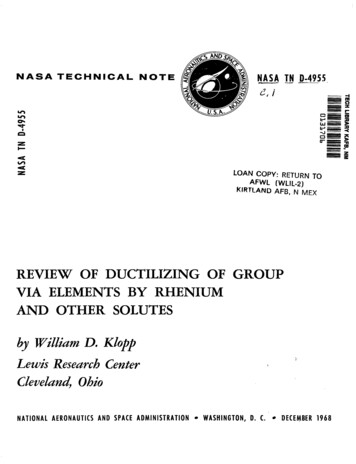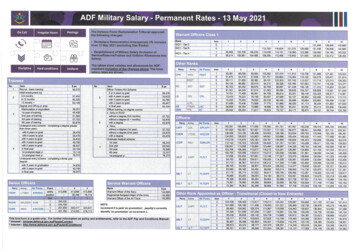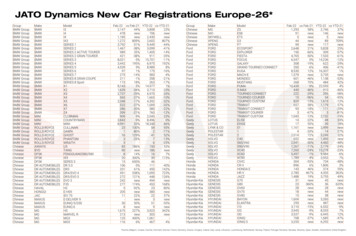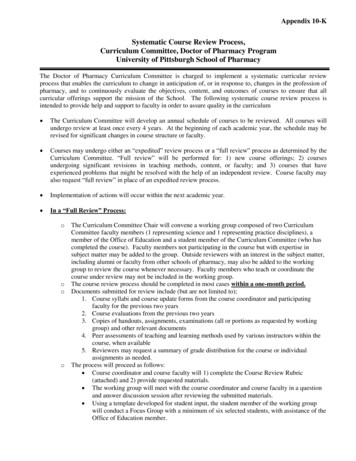
Transcription
NASA TN- D-49Li--LLOAN COPY: RETURN TOAFWL (WLIL-2)KlRTLAMD AFB, N MEXREVIEW OF DUCTILIZING OF GROUPVIA ELEMENTS BY RHENIUMAND OTHER SOLUTESby WiZliam D. KZoppLewis Research CenterCZeveZand, OhioN A T I O N A L AERONAUTICS AND SPACE A D M I N I S T R A T I O NWASHINGTON, D. C.DECEMBER 1968
I!TECH LIBRARY KAFB, NMIl1ll1l11OL3L70b1llllllul 1111111NASA T N D-4955REVIEW OF DUCTILJZING OF GROUP VIA E L E M E N T SBY RHENIUM AND OTHER SOLUTESBy W i l l i a m D. KloppLewis Research CenterCleveland, OhioNATIONAL AERONAUTICS AND SPACE ADMINISTRATIONFor sale by t h e Clearinghouse for Federal Scientific and Technical InformationCFSTI price 3.00Springfield, Virginia 22151-
ABSTRACTThe ductility of Group VIA alloys containing rhenium and other solutes from GroupsM A and VIIIA was reviewed. The rhenium ductilizing effect, found in Group VIA alloyscontaining 25 to 35 at. %Re, is promoted by other solutes from Group VIIA and the earlyportions of Group VIIIA. The hardness minimums and lowered ductile-brittle transitiontemperatures observed in dilute Mo-Re and W-Re alloys are attributed to solutionsoftening. This phenomenon occurs at low temperatures and i s common to many dilutebody-centered-cubic alloys containing substitutional solutes.'Iii
CONTENTSSUMMARYPage.INTRODUCTION.1.1PROPERTIES OF GROUP VIA-RHENIUM ALLOYS . . . . . . . . . . . . . . . .Phase Diagrams . . . . . . . . . . . . . . . . . . . . . . . . . . . . . . . . . .Hardness . . . . . . . . . . . . . . . . . . . . . . . . . . . . . . . . . . . . . .Twinning . . . . . . . . . . . . . . . . . . . . . . . . . . . . . . . . . . . . .Ductile- Brittle Transition Behavior . . . . . . . . . . . . . . . . . . . . . . . .High-Temperature Properties . . . . . . . . . . . . . . . . . . . . . . . . . . .PROPERTIES OF GROUP VIA-RHENIUM ANALOG ALLOYS . . . . . . . . . . .Chromium Alloys . . . . . . . . . . . . . . . . . . . . . . . . . . . . . . . . . .Phase diagrams . . . . . . . . . . . . . . . . . . . . . . . . . . . . . . . . .Hardness . . . . . . . . . . . . . . . . . . . . . . . . . . . . . . . . . . . . .Twinning . . . . . . . . . . . . . . . . . . . . . . . . . . . . . . . . . . . .Ductile-brittle transition behavior . . . . . . . . . . . . . . . . . . . . . . . .High-temperature properties . . . . . . . . . . . . . . . . . . . . . . . . . .Molybdenum Alloys . . . . . . . . . . . . . . . . . . . . . . . . . . . . . . . . .Phase diagrams . . . . . . . . . . . . . . . . . . . . . . . . . . . . . . . . .Hardness . . . . . . . . . . . . . . . . . . . . . . . . . . . . . . . . . . . . .Twinning . . . . . . . . . . . . . . . . . . . . . . . . . . . . . . . . . . . . .Fabricability and ductility . . . . . . . . . . . . . . . . . . . . . . . . . . . .Tungsten Alloys . . . . . . . . . . . . . . . . . . . . . . . . . . . . . . . . . . .Phase diagrams . . . . . . . . . . . . . . . . . . . . . . . . . . . . . . . . .Hardness . . . . . . . . . . . . . . . . . . . . . . . . . . . . . . . . . . . . .Fabricability . . . . . . . . . . . . . . . . . . . . . . . . . . . . . . . . . . .DISCUSSION . . . . . . . . . . . . . . . . . . . . . . . . . . . . . . . . . . . . . .Rhenium Ductilizing Effect . . . . . . . . . . . . . . . . . . . . . . . . . . . . .Solution Softening Effect . . . . . . . . . . . . . . . . . . . . . . . . . . . . . .Suggested Areas for Future Research . . . . . . . . . . . . . . . . . . . . ONCLUSIONS.28REFERENCES.29iii
REVIEW OF DUCTlLlZlNG OF GROUP V I A ELEMENTSB Y RHENIUM AND OTHER SOLUTESby W i l l i a m D. KloppLewis Research C e n t e rSUMMARYThe properties of Group VIA-base alloys with rhenium (Re) and with other solutesfrom Groups VIIA and VIIIA were reviewed to determine correlations pertinent to thelowered ductile-brittle transition temperatures observed in both near-saturated and diluteGroup VIA-Re alloys. The rhenium ductilizing effect, originally observed in chromium(Cr), molybdenum (Mo), and tungsten (W) alloys containing 25 to 35 atomic percent Re, isnot specific to rhenium but is also found in alloys with other solutes from Group VIIA andthe early portions of Group VIIIA. The ability of a solute to promote the rhenium duc tilizing effect is related to the position of the solute in the periodic table.The decreased hardnesses and lowered ductile-brittle transition temperatures ob served in dilute Group VIA-Re alloys are attributed to the phenomenon of solution soften 'ing. This phenomenon occurs at temperatures below about 0. 2 of the absolute meltingpoint (Tm) and increases in magnitude with decreasing temperature. Although additions ofrhenium a r e more effective than those of other Group VIIA and VIIIA elements in soften ing the Group VIA elements, the phenomenon is apparently present in most body centered-cubic alloys containing small additions of substitutional solutes. The softeningeffect is related to a decrease in the Peierls s t r e s s on alloying.INTRODUCTIONIn 1955, Geach and Hughes (ref. 1) reported on the remarkable plasticity of Mo-35Re and W-25Re alloys. These alloys could be warm fabricated from the cast condi tion and finished cold, whereas unalloyed molybdenum and tungsten require hot extrusionto break down the cast structure before hot rolling.' 1 1compositions in atomic percent.
The cold ductility of these alloys has been extensively studied by Jaffee and his co workers (refs. 2 to 5). Both alloys a r e significantly more ductile than the unalloyedmetals and deform initially by twinning. Klopp, et al, (ref. 6) also found that Cr-35Reis analogous to the molybdenum and tungsten alloys with respect to structure, fabrica bility, and cold ductility. Jaffee and his coworkers attributed the unusual behavior ofthese alloys to(1) A reduction in the solubility limit for oxygen(2) An increase in surface tension of the intergranular oxide(3) A reduction in the stacking fault energy, resulting in easier twinningIn 1960, Robins (refs. 7 and 8) suggested that the improved ductilities were associ ated with decreased oxygen solubility caused by an increase in the electron-atom ratiowhen rhenium was added. According to this theory, the electron resonance contributionto the bond strength is at a maximum for the Group VIA elements and is in part respon sible for the low interstitial solubilities in these elements. Electron-donor elementsfrom Group VIIA (such as rhenium) and from Group VIIIA increase the electron-atomratio and produce a corresponding decrease in the solubilities of the interstitial donorelements.Subsequent studies conducted by Gilbert, Reid, and Hahn (ref. 9), Klein (refs. 10and l l ) , Gilbert, Klein, and Edington (ref. 12), Allen (refs. 13 and 14), and Booth,Jaffee, and Salkovitz (ref. 15) were not able to establish the validity of hypotheses (1)and (2). Gilbert, el al. (ref. 9) observed larger strain aging peaks in Cr-35Re than inchromium, attributable to an increase in the amount of dissolved nitrogen. Klein (refs.10 and 11) showed that the equilibrium solubility of nitrogen in chromium is essentiallyunchanged by alloying with rhenium. However, he observed that the nitride precipitationkinetics a r e much slower in Cr-35Re than in chromium, which allows more nitrogen toremain in solid solution and probably accounts for the large strain aging peaks. This ob servation, plus lack of any supporting evidence for an increase in oxygen solubility, hascast doubt on hypothesis (1). With regard to hypothesis (2), Gilbert, e t al. (ref. 12) con cluded that a change in grain-boundary oxide morphology is probably unimportant to the"rhenium ductilizing effect" since cracks in the Group V I A metals a r e frequently initi ated at clean grain boundaries and propagate by intragranular cleavage, rather than in tergranularly. Allen also showed (refs. 13 and 14) that rheium has no significant effecton the surface tension of the Group VIA metals. Gilbert, e t al. (ref. 12) consider im portant the observation that rhenium alloying changes the preferred slip plane in theGroup VIA metals from { 110 } to { 112 } , since this change increases the number of avail able slip planes from 6 to 12 and thus increases the ease of cross-slip.In 1964, Wukusick (ref. 16) proposed that the rhenium ductilizing effect is related tospinoidal decomposition. Specifically, he suggested that the Group VIA-Re and the Cr-20ruthenium (Ru) alloys exhibit solute clustering with increasing solute content. The solute2
clusters, being regions of high atomic disarray, are also sites for interstitial clustering,so that the interstitial content of the matrix is reduced. The matrix, then, being rela tively free of dissolved interstitials, is more ductile. To the extent that the improvedductility is related to matrix cleanliness, the hypotheses of Wukusick and of Jaffee, et al.are similar.More recently, Stephens and Klopp (ref. 17) proposed that the rhenium ductilizing ef fect is associated with the high solubility for rhenium in the Group VIA elements and thepresence of an intermediate sigma phase. Sigma phase nuclei were postulated to providestress concentration sites that could act as sources for dislocations and twins.During the early studies of the rhenium ductilizing effect, a second rhenium phenom enon was noted. Jaffee, Sims, and Harwood (ref. 4) observed a significant hardness de crease on adding about 5 atomic percent rhenium to molybdenum. Subsequent studies byPugh, Amra, and Hurd (ref. 18) on W-Re alloys, and by Allen and Jaffee (ref. 19) onCr-Re alloys established that dilute alloys in these systems also exhibited lower hardnessvalues than either the unalloyed elements or the more concentrated alloys. This phenom enon, now considered to be "solution softening, t f 2 is common to most dilute substitu tional body-centered-cubic alloys at low temperatures. Solution softening was shown tobe associated also with decreased ductile-brittle transition temperature in dilute Mo-Realloys by Witzke (unpublished data obtained at Lewis) and in W-Re alloys by Pugh, et al.(ref. 18) and Klopp, Witzke, and Raffo (ref. 20).This report is a review of the properties of the Group VIA-Re alloys pertinent toboth the rhenium ductilizing effect and the solution-softening effect. The properties ofother alloys exhibiting similar effects are also reviewed with the view of establishingproperty correlations to aid in both understanding these effects and extending their duc tility benefits to other systems. Areas of interest for further studies on these effectsare suggested.PROPERTIES OF GROUP VIA-RHENIUM ALLOYSPhase DiagramsPhase diagrams for the Cr-Re (ref. 21), Mo-Re (refs. 22 to 24), and W-Re (refs. 25and 26) systems are presented in figure 1. These systems are similar, being character 21n the following discussions, the term "rhenium ductilizing effect" is used withreference to the effects promoted by additions of about 2 0 at. %J or more of rhenium o rrhenium analog solutes, while the t e r m "solution softening'? will be used with referenceto the effects promoted by less than about 10 at. %J of rhenium o r of other solutes.3
im14001800(a1 Chromium-rhenium system (ref. 211.3n"0MoRhenium, a t I(bl Molybdenum-rhenium system (refs. 2 to 241.m mMoo-2600 -2600 -m 180018w --1400 1400 Rhenium, a t %Wicl Tungsten-rhenium system (refs. 25 and 261.Figure L4- Phase diagrams d Group VIA-rhenium systems.100Re
ized by a high solubility for rhenium in the body-centered-cubic terminal phase, rangingfrom 37 atomic percent in tungsten to 50 atomic percent in chromium, and by the pres ence of an intermediate sigma phase. In addition, the Mo-Re and W-Re systems exhibitan Re3X chi phase.Hard nessThe room-temperature hardnesses of the Group VIA-Re alloys are shown in fig ure 2.The solution-softening effect is apparent in the hardness minimums at low rheniumlevels in all three systems. The hardness decreases in molybdenum and tungsten arelarge (35 to 60 points, Vicker's hardness scale) and the minimums occur at rheniumlevels of 4 to 6 atomic percent. In contrast, the hardness decrease with chromium issmall (2 to 13 VHN points), while the minimum occurs at a rhenium level of 0. 6 atomicpercent (ref. 19). These differences in hardness behavior a r e attributed in part to thedifferences in homologous temperature at which the hardnesses were measured, sincethe solution-softening effect diminishes with increasing homologous temperature. RoomQP Iloo 0110I11-12030Rhenium, a t ZII40IIMFigure 2. - Hardnesses of Group VIA-rhenium alloys at roam temper ature (refs. 1, 2, 4, 6, 12, 19. 20, 27, 28).5
temperature is 0.14 Tm f o r chromium, but only 0.08 Tm for tungsten.The rates of hardening between the initial hardness minimums and the entrance intothe two-phase region are similar for all three systems, which suggests that factors otherthan solvent-solute atomic size considerations control solution hardening at low tempera tures. At elevated temperatures, size effects may become important since dilute and in termediate W-Re and Mo-Re alloys with only a 1.4-percent size difference can be readilyhot rolled (refs. 6 and 27), whereas Cr-3 to Cr-30Re alloys, with a 9.4-percent sizedifference, could not be hot rolled at 800' to 1033' C (1073 to 1306 K) (ref. 17.).As the composition approaches the terminal solid solubility limit, the hardnesscurves flatten o r decrease slightly, and a sharp rise follows associated with the appear ance of the brittle sigma phase. The compositions in the hardness-plateau region exhibitthe improved low-temperature ductility and twinning that are associated with the rheniumductilizing effect.700r0TemperatureFraction of-253 (20)0.01Rhenium, at. %Figure 3. - Effects of temperature on hardness of chromium-rheniumalloys (refs. 6, 12, and 19).Figure 3 illustrates the temperature dependence of the solution softening effect inCr-Re alloys. At 20' and -76' C (293 and 197 K), the curves show the expected hardnessincreases with increasing rhenium content. However, a t - 196' and -253' C (77 and 20 K)the hardness decreases with increasing rhenium up to about 20 atomic percent afterwhich a region of approximately constant hardness is observed. Gilbert, et al. (ref. 12)6
also observed similar hardness trends in the Mo-Re and W-Re systems, as shown in fig ure 4. These hardness trends reflect the increasing magnitude of the. solution-softeningeffect at low temperatures with regard to both the extent of the hardness decrease andthe rhenium level at which the minimum hardness occurs.Raffo (ref. 28) similarly showed that the yield stress in W-Re alloys decreases withincreasing rhenium content to at least 9 atomic percent rhenium at -196' C (77 K). Lowtemperature solution softening was observed also in tantalum (Ta)-Re and Ta-Mo alloys byRaffo and Mitchell (ref. 29), in iron-nickel (Fe-Ni) and Fe-platinum (Pt) alloys by9\900Fraction of TemperatureabsoluteocKmelting point,TmMo-Re0.1020 1293)Mo-Re.007-253 (20).005-253 (20)W-ReW-Re.0820 (293)Alloy\\o00800 '0A700 .40030020010050Figure 4.1015Solute, at. %20"2530- Hardness curves for Mo-Re and W-Re alloys at -253" C(20 K) and 20" C (293 K) (ref. 12).Kranzlein, Burton, and Smith (ref. 30), and in Fe-Mo alloys by Urakami, Marcus,Meshii, and Fine (ref. 31). However, in these other systems, the softening is limitedt o a yield strength minimum at compositions in the range of 2 to 4 atomic percent and isfollowed by solution strengthening at higher solute contents. Thus, the Group VIA-Realloys appear unusual in that little strengthening o r hardening occurs with increasingrhenium content at low temperatures.7*
TwinningA prominent feature of the rhenium ductilizing effect (at high rhenium levels) is thatinitial deformation of the ductile alloys at low temperatures (less than about 0.25 Tm) isaccompanied by twinning, as shown in figure 5. The importance of twinning to the rhenium ductilizing effect is not well understood, particularly since twinning accounts foronly a minor fraction of the observed deformation, with slip accounting for the remainder.Figure 5. - Twinninq in bent tungsten - 24-atomic-percent rhenium (unpublished dataobtained by W. R. WitzKe of Lewis).The effects of composition on twinning are shown in figure 6 for the Cr-Re system.The temperature at which twinning is observed around a hardness impression increasessharply with increasing rhenium content above 15 atomic percent. Similar relationsprobably hold for Mo-Re and W-Re alloys, as well, although the temperature-compositiondependencies of twinning have not been documented quantitatively in these systems.The occurrence of twinning in the Group VIA-Re alloys may be related to a decrease in the stacking fault energy, as suggested by the results of Votava for Mo-35Re(ref. 32) and by Aqua and Wagner for W-20Re (ref. 33). However, since the twinningstrain by itself can account for only a small fraction of the observed ductility, and in8
0 0 0 0 0100 '0152025Rhenium, a t %303540Figure 6. - Temperature-composition relation for twinning aroundhardness impressions in cast, homogenized chromium-rheniumalloy buttons (from ref. 12).view of the recent suggestion (ref. 28) that decreased stacking fault energy can also leadto e a s i e r deformation by s l i p in body-centered-cubic alloys, it now appears possible thattwinning is associated with, but is not necessary to, the rhenium ductilizing effect.Ductile- B rittle Transition BehaviorThe small amount of data available for Cr-Re alloys indicate that the bend ductilebrittle transition temperature is reduced from 150' C (423 K) for recrystallized un alloyed chromium to about -196' C (77 K) for Cr-35Re to Cr-40Re (refs. 6 and 17). Adecrease in the ductile-brittle transition temperature relative to unalloyed C r was alsoobserved by Carlson, Sherwood, and Schmidt (ref. 34) for a Cr-O.03Re alloy under slowbending conditions where the ductile-brittle transition temperature of unalloyed chromiumwas -40' C (233 K). This decrease under low-temperature testing conditions reflects thetemperature dependency of the solution-softening effect.Rhenium additions to molybdenum progressively reduce the transition temperaturein the recrystallized condition, as shown in figure 7(a). A smaller decrease in thetransition temperature with increased rhenium content is apparent in worked Mo-Realloys. Note that the Mo-35Re alloy is ductile to a lower temperature in the recrys tallized than in the worked condition. Unpublished data (obtained by W. R. Witzke OfLewis) also indicate a decrease in the ductile-brittle transition temperature relative tounalloyed molybdenum for an electron-beam-melted Mo-4Re alloy.9
1100\0I-273\(a) Arc-melted molybdenum-rhenium alloys (ref. 6).-,Recrystallized\\\\\\4-\W,\ orked‘\O L-273‘\II. II!IRhenium, at. 46(b) Electron-beam-melted tungsten-rhenium alloys (ref.M).Figure 7. - Ductile-brittle bend transition temperatures formolybdenum-rhenium and tungsten-rhenium alloys.10
F o r the recrystallized W-24Re alloy, the improvement in the transition tempera ture relative to the unalloyed metal is less than in the Cr-Re o r Mo-Re system, possiblyreflecting the lower solubility for rhenium in tungsten than in the other two Group VIAmetals. In contrast to Mo-Re, the W-26Re alloy can be bent at much lower tempera tures in the worked condition than in the recrystallized condition.The effect of grain size on the ductile-brittle transition temperature of W-Re alloysis shown in figure 8. The grain size effect in W-24Re and W-26Re is similar to that ob served by Seigle and Dickinson (ref. 35) f o r unalloyed tungsten. At similar grain sizes,the alloys are ductile to about 140' C (413 K) lower than unalloyed tungsten.Y0 Electron-beam melted W - 24 Re0 Arc-melted W - 26 Re1246 81020Average recrystallized grain diameter, cm40x10-3Figure 8. - Bend transition temperature for recrystallizedtunqsten (ref. 35) and tungsten-rhenium (ref. 20 andunpublished work of W. R. Witzke of Lewis) as functionof grain size.High-Temperature PropertiesIt has recently been shown by Garfinkle, et al. (ref. 27) that W-Re alloys exhibitsuperplasticity at elevated temperatures for compositions near the solvus line. Themost prominent feature of this phenomenon is the increase in tensile elongation with in creasing rhenium content at 2000' C (2273 K) (fig. 9). At this temperature, the W-25Re alloy exhibited more than 180 percent elongation in a tensile test. The proximity ofthe elongation peak to the solvus line is consistent with previous observations in superplastic systems, as described by Underwood (ref. 36) and by Weiss (ref. 37).11
r/120n\a/1330" C (1773 K)Figure 9. - Tensile elongations of electron-beam-melted tungsten-rheniumalloys annealed for 1 hour at 2MO" C (2573K) (ref. 27).PROPERTIES OF GROUP VIA-RHENIUM ANALOG ALLOYSDuring the last few years, numerous attempts have been made to duplicate the rhe nium ductilizing effect in Group VIA metals using alloying elements other than rhenium.These potential rhenium analogs have generally been located in Groups VIM and VllL4 ofthe periodic table, shown in table I. The purpose of such studies has been to gain abetter understanding of the mechanisms of the effect and, if possible, to reproduce theeffect with alloy additions less expensive than rhenium. The selection of alloying addi tions and the levels studied have been based on several criteria, including similaritiesin electron to atom ratios and phase diagrams. The properties of the various potentialrhenium-analog systems studied are discussed in the following sections.TABLE I.- PARTIAL PERIODIC TABLEGroup GroupVIA VILAGroup VIIIAj 24Fourth period2758.94 ' 58.71 I52.01 54.94L 42Fifth period43I 28.1Co NICr #n444546777895.95, (99) , 101.1-74Sixth period75764IW Re Os Ir Pt12,183.86,186.22 190.2 1 192.2 195.09!LNumber of s andd electrons1Rh PdM i Tc Ru 102.91106.4,67'8910
Chromium AlloysSeveral studies were conducted on chromium-base systems, both at dilute (refs. 17,19, 34, 38, and 39) and concentrated alloying levels (refs. 16, 17, 19, 38, 40, and 41).The concensus of these studies is that there are probably five solutes which can be con sidered as analogs to rhenium in chromium with respect to the rhenium ductilizing ef fect. These solutes are cobalt (Co), Fe, manganese (Mn), osmium (Os), and Ru. Tech netium (Tc) is also a potential rhenium analog, although Cr-Tc alloys have not beenstudied.Phase diagrams. - Phase diagrams for Cr-Co, Cr-Fe, Cr-Mn, and Cr-Ru systemsa r e shown in figure 10. All four systems have three features in common: (1) the soluteis from Group VIIA o r VIIIA; (2) the solute has a high maximum solubility in chromium;and (3) the system contains an intermediate sigma phase. These features are also com mon to all three Group VIA-Re systems. - Hardness data for Cr-Re and the five systems which appear analogousHardness.to Cr-Re are presented in figure 11 (refs. 17, 19, 38, and 42). An important observa tion is that the solution-hardening rates, which can be represented as parabolic func tions of composition, are a function of the position of the solute in the periodic table(ref. 17). Rhenium and manganese, from Group VIIA, harden chromium at a similarrate up to about 25 atomic percent solute, while iron, ruthenium, and osmium, from thefirst series in Group VIIIA, also have a common but higher hardening rate. Cobalt,from the second s e r i e s in Group VIIIA, has the highest hardening rate of these sixsolutes in chromium. The hardening rates of these and other Group VIIIA solutes aregiven in table II. The trend for increasing hardening rates with increasing number of sand d electrons suggests that electronic interactions dominate the solution-hardeningrates at low temperatures.A second point of interest from figure 11 is that all six solutes promote a hardnessdecrease in chromium at high alloying levels. In the alloys of chromium with osmium,ruthenium, cobalt, and rhenium, this softening occurs at compositions slightly less thanthe solubility limit; in the Cr-Fe and Cr-Mn systems, softening occurs above 25 o r40 atomic percent solute, respectively, well below the maximum solubilities of thesesystems. These hardness decreases are correlated approximately with the onset ofmechanical twinning.It is also shown in table 11 that solution softening is promoted by dilute additions,l e s s than 1 atomic percent solute, of these six solutes. This softening was studied byAllen and Jaffee (ref. 19) and was shown to occur in chromium with dilute additions ofall Group IVA, VA, VIA, VIIA, and VIIIA elements. The solute contents at the hardness13I
m 1800-1600-1400 - -1wo1wo -8001m-0yPII600 YfaI10MM40Cr50607080Cobalt, a t SbW 1 WIron, a t kco(a) Chromium-cobalt system (ref. 44).5(b) Chromium-iron system (refs. 44 and 45).2400Moo1800-1600-1400-1m loo0 --16001400-41ma1wo 800MM0Cr10MM40-M60Manganese,!se. a t %1-."7080"V9 0 1 1WW90Mn(c) Chromium-manganese system (refs. 44 and 45).Figure 10.(d) Chromium-ruthenium system (refs. 40 and 45).- Phase diagrams of chromium-base systems.
I.010203040 -1I506070Solute, at. %Figure 11.- Hardness of chromium alloy systems (refs.17, 19, 38, and 42).minimums were lower for Group VIlLA than for Group VIIA elements and tended t o de crease with increasing number of s and d electrons in the solute. The small amount ofsoftening and the low solute concentrations at which the softening is found relative torhenium in molybdenum and tungsten reflect in part the high homologous temperature ofchromium at room temperature, 0.14 Tm. In contrast, room temperature is equivalentto 0. 10 Tm for molybdenum and 0.08 Tm for tungsten.-Twinning. - Mechanical twinning has been observed in four of the five apparent rhe nium analog systems with chromium. The solute levels in atomic percent for twinningare as follows: 26 to 63 IvIn, 19 to 5 1 Fe; 18 to 25.5 Ru; and 30 Co (refs. 17, 19, 28,38, and 40). In all cases, the twins were mechanical, that is, observed near hardnessimpressions or in deformed bend specimens, and were similar to those observed in theCr-Re, Mo-Re, and W-Re alloys. Twins were not observed in alloys with 6 to 15 Os(ref. 17).15
TABLE It.- HARDENING BEHAVIOR OF GROUPS MA AND VIIIASOLUTES IN CHROMIUM AND MOLYBDENUMIHardening rateaLocation ofLocation ofhardness minimum,ductile-brittleat. %solutetransition temperatureIs and d electronsin solute-Chromium-base 1963442421. 512.651.86.1.1.1oscoRhMolybdenum-base alloys70.31FeRu888.73.76.72. 11.25.58RhIr9991.27.761. 19. 10. 14NiPt10101.781.29oscoindicates solute concentration,'Data for Cr are from ref. 19.L IReit.4.5.20I.05.14(& WIN base is 130 for Cr,190 for Mo.
Ductile-brittle transition behavior. - The bend transition temperatures for Cr-Reand the five other chromium systems under discussion are shown in figure 12. Substan tial decreases in the ductile-brittle transition temperatures are evident in the concen trated Cr-Ru, Cr-Co, and Cr-Fe alloys. In the Cr-Co and Cr-Fe alloys, quenchingafter annealing was required in order to prevent sigma precipitation, which raises thetransition temperature. Although improved bend ductility has not yet been documentedfor Cr-Os alloys, Wukusick (private communication, June, 1967) was able to cold roll achill-cast Cr-220s alloy, suggesting that osmium is a rhenium analog in chromium.No improvement in the ductile-brittle transition temperature of chromium by dilutealloying was observed by Stephens and Klopp (ref. 17). However, Carlson, et al.(ref. 34), by bending chromium slowly under conditions where the unalloyed form has atransition temperature of -40' C (233 K) , observed substantial transition temperaturedecreases on dilute alloying of chromium with most of the elements from Groups VA,VIA, VIIA, VIIIA, and IB. The observations of improved ductile-brittle transition tem under low-temperature testing conditions and no improvement under higher temperaturetesting conditions reflect the temperature dependency of the solution-softening effect.The estimated solute contents for minimum ductile-brittle transition temperaturefrom the work of Carlson, et al. are given in table II. The locations of the minimumsare similar to the locations of the hardness minimums, both tending to decrease with in "t100Solute, at. 70Figure 12. - Ductile-brittle transition temperatures for chromium alloys in recrystallizedand quenched condition (4Tbend radius) (ref. 17).17
creasing number of s and d electrons in the solute. It is also noted that the solute con tent at the transition temperature minimum tends to increase with increasing periodnumber of the solute for solutes in the same periodic group.High-temperature properties. - Unusually high tensile elongations have recentlybeen reported for near-saturated single-phase alloys in the Cr-Co and Cr-Ru systems byStephens and Klopp (refs. 17 and 43). While these elongations (up to 160 percent) arelow compared with those reported for superplastic materials, the trends are similar tothose observed for W-Re alloys.These observations suggest that high tensile elongations at elevated temperaturesare another common characteristic of alloys exhibiting the rhenium ductilizing effect.Molybde nu m A IIoysSeveral molybdenum-base systems have been studied with respect to the rheniumductilizing effect by Klopp, et al. (ref. 38). Although improved fabricability was pro moted by a number of solutes, no improvements in the bend transition temperatureswere observed.Phase diagrams. -.On the basis of the phase relations suggested by Stephens andKlopp (ref. 17), five solutes appear as potential rhenium analogs in Mo, namely, man ganese, technetium, iron, ruthenium, and osmium. These five elements are fromGroups VILA and VIIIA, form an intermedi
The rhenium ductilizing effect, originally observed in chromium (Cr), molybdenum (Mo), and tungsten (W) alloys containing 25 to 35 atomic percent Re, is not specific to rhenium but is also found in alloys with other solutes from Group VIIA and the early portions of Group VIIIA. The ability of a solute to promote the rhenium duc










